Abstract
VarroMed® is a soft acaricide registered for honey bees on the European Union market since 2017 for Varroa control. Researchers involved were partners of different countries of the Varroa control task force of the COLOSS Association. Our goal was to evaluate performances (acaricide efficacy and toxic effects on honey bees) of VarroMed® in different climatic conditions. Our results in the tested apiaries showed an efficacy ranging from 71.2 to 89.3% in summer/autumn, and from 71.8 to 95.6% in winter. No toxic effects on bees were observed, except in one apiary, where severe cold climatic conditions played a crucial role. The treatment could be efficiently applied in broodright as well as in broodless colonies. Integrated pest management (IPM) recommendations for beekeepers are provided in order to apply the best Varroa control protocol.
1. Introduction
The mite Varroa destructor [1] is one of the main threats to the European honeybee Apis mellifera and, thus, for the beekeeping sector [2]. The number of suitable veterinary medicine products (VMPs) for the treatment is limited [3] due to the need of low honey bee toxicity [4], the risk of residues in honey bee products [5,6] and the V. destructor mite capability to develop resistance to the frequently used active substances [7]. In this context, the availability of new VMPs in the market, as well as upgraded treatment measures or tools (i.e., brood interruption techniques) can be valuable help for beekeepers [4,8].
From previous studies, it is known that soft acaricides [7] have one or more components as an active ingredient: organic acids (oxalic [9,10,11,12,13], formic [14,15,16] and lactic acid [17]), other acids [18], thymol [19,20,21,22] and other essential oils [23,24]. Recently, different formulations of natural ingredients were evaluated, such as a formulation composed of oxalic acid, thymol and oregano oil [25], and some were compared or combined with brood interruption technique [8,26]. Since 2017, VarroMed®, an organic acid-based VMP against Varroa was registered for its use on the honey bees in EU.
In the context of the Varroa control task force of the COLOSS association [27], we decided to test the performances of VarroMed® concerning efficacy against Varroa mite and toxicity for honey bees in different European climatic conditions in agreement with EMA guidelines [28], following the instructions given by the producer.
The aim of our study was to test the application of VarroMed® in different conditions and to give detailed and reliable information to European beekeepers in the framework of a Varroa management strategy.
2. Materials and Methods
The active ingredients of VarroMed® (BeeVital GmbH, Handelstrasse 65162 Pbertrum am See, Austria) are formic acid (5 mg/mL) and oxalic acid dihydrate (44 mg/mL). Other ingredients in the product include caramel color (E150d), sucrose syrup, propolis tincture (20%), citric acid monohydrate, lemon (Citrus limon) essential oil, star anise (Illicium verum) essential oil and pure water. There is no specific range of environmental temperature or humidity for the use of VarroMed® indicated by the producer.
We evaluated the performances of VarroMed® in Italy (temperate continental/Mediterranean climate), Slovenia and Croatia (moderately warm and rainy continental climate) and Belgium (maritime temperate climate) in 2018. The protocol was structured in accordance with the European Medicines Agency (EMA) guidelines on VMPs for controlling V. destructor parasitosis in bees [28]. It was designed by the group of participants of the Varroa Control Task Force (COLOSS association). A summary scheme of the activities and their timing is presented in Figure 1, Figure 2 and Figure 3.
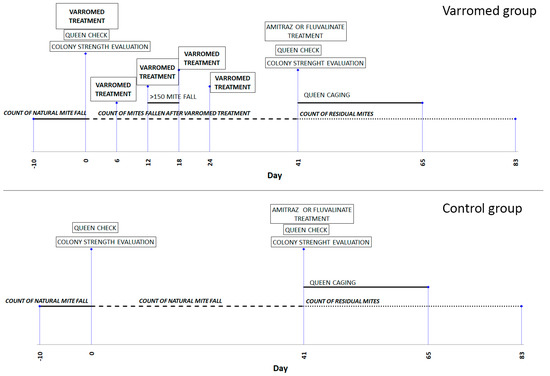
Figure 1.
Summer/autumn protocol for the treated group (five repeated treatments) and control group. The following two treatments are additionally applied, if more than 150 mites are detected on the sticky boards within 6 days after the third treatment.
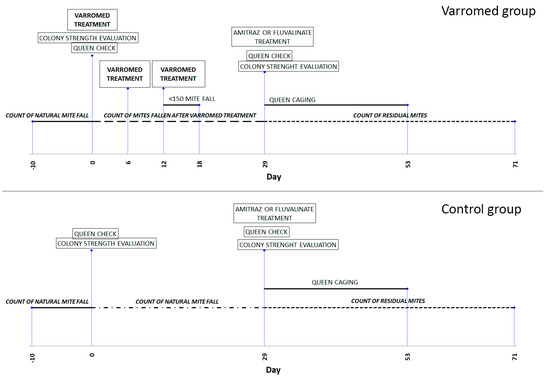
Figure 2.
Summer/autumn protocol for the treated group (three repeated treatments) and control group. Only three treatments are needed, if less than 150 mites are detected on the sticky boards.

Figure 3.
Winter protocol for the treated and control group in broodless colonies.
Honey bee colonies were set up in 10-frame Dadant-Blatt (DB), Langstroth Root (LR) or AŽ (Alberti-Žnideršič) hives, and placed in the same apiary each. We established two protocols: a summer/autumn protocol and winter protocol.
The trials were carried out in absence of honey-flow and honey supers. Two experimental groups homogenous in strength and Varroa infestation levels were organized for each trial. In both protocols, the colonies were treated with VarroMed® (treated group), while the other group was left untreated (control). The main differences between the two protocols were the absence of brood during the winter protocol versus its presence during the summer/autumn protocol, and the duration of the treatment due to the number of VarroMed® applications. According to label instructions, the treatments in autumn should be performed according to decreasing colony population, 3 to 5 times, 6 days apart. In winter, it should be applied once only, at the start of the broodless period and in hives with Varroa infestation.
The summer/autumn protocol was evaluated in Italy, Slovenia, Croatia and Belgium, once per country, and the winter protocol was only carried out by three institutions in Italy and one in Croatia. The protocol followed by the participants and the number of honey bee colonies used for each trial are summarized in Table 1.

Table 1.
Number of hives used in each trial and location.
In order to evaluate the variation of the colony strength due to the VarroMed® treatment, the number of adult bees and brood coverage was estimated [29] immediately before the beginning and after the end of the treatment period.
According to manufacturers’ indications, VarroMed® was warmed at 25–35 °C, shook before its use and administered between the hive frames fully occupied by bees. The dose was adjusted to the colony size according to dosage instructions of the producer. On the day of the first VarroMed® treatment (day 0 of the protocol—see Figure 1, Figure 2 and Figure 3), the presence of the queen was checked, and colony strength was assessed in both groups. In order to calculate the acaricidal efficacy, mites fallen during the trial were counted every 2 to 3 days by inserting sticky boards. For the summer/autumn protocol, boards were checked until 17 days after the beginning of the last VarroMed® treatment, considering the number of days of efficacy on dispersal mites (6 days as described in the leaflet) and for more than 11 days to evaluate the eventual efficacy of the treatment on mites inside the capped brood cells susceptible to Varroa (Figure 1, Figure 2 and Figure 3).
For the winter protocol, boards were checked until 14 days after the VarroMed® treatment.
A follow-up treatment consisting of the application of synthetic miticides with different mechanism of action based on amitraz and tau-fluvalinate (in combination or in double dose), in order to avoid low efficacy due to possible mite resistance to one of the active substances, was applied to verify the residual number of mites. We used VPMs registered for honey bees with active substances not present in VarroMed®.
In the summer/autumn protocol, all queens were caged in VAR-CONTROL cages (Api-Mo.Bru, Campodoro, Padova, Italy—http://www.apimobru.com (accessed on 13 September 2021) for 24 days. The follow-up treatment was applied during the caging period and for more 18 days. The residual number of mites was counted on sticky boards during the whole timeframe [25,30].
In brood absence (winter treatment), residual mites were counted on the sticky boards for 14 days after the follow-up treatment [25,30].
The untreated colonies of all control groups were checked for the natural mite fall and received the same follow-up treatment.
The percentage of acaricidal efficacy (AE) in each hive was evaluated using the formula: AE = (VT/VT+follow-up) × 100, where VT is the total number of mites killed by the VarroMed® treatment, not considering the mites fallen during the queen caging period, and VT+follow-up represents the total number of mites killed by the tested treatment and the follow-up treatments [31].
During the experiments, mean environmental temperatures were recorded by weather stations near the apiaries.
Statistical analysis was performed using XLSTATTM software [32]. It was verified if differences in acaricide efficacy were statistically significant using a Mann–Whitney Test [33]. The amount of adult honey bees and brood coverage between groups (treated and control) was evaluated using Kruskal–Wallis Test [34]. For the latter, multiple pairwise comparison with Dunn’s Test [35] was applied with Bonferroni correction.
3. Results
3.1. Summer/Autumn Trial
Acaricide efficacy of VarroMed® recorded during the summer/autumn trial ranged from 71.2%, when applied three times (Croatia), to a maximum of 89.4% (Belgium) when applied five times (Table 2; Figure 4). All treated groups efficacies differed from control groups (Kruskal–Wallis test: H(7) = 59.14, p < 0.0001; Dunn’s tests: p < 0.05). There were no statistically significant differences recorded between the locations, and the number of applied treatments (three or five) was not related to the natural mite fall rates before treatment.

Table 2.
Acaricide efficacy recorded during the summer/autumn trial in the apiaries and relative mite fall during the same period in the control group (%).
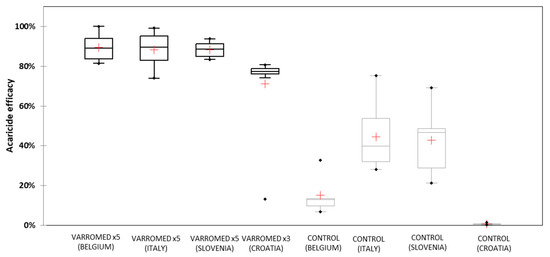
Figure 4.
Box plot of acaricide efficacies recorded during the summer/autumn trial and relative mite fall during the same period in the control group (%). The horizontal line in boxes shows the median. The box shows the first and third quartile. Whiskers extend to 1.5 × interquartile range (IQR). Diamonds mark the outliers outside the 1.5 × IQR. Additionally, the pluses show mean values.
The number of adult bees was reduced in treated groups, compared to the control ones, in Belgium, Italy and Slovenia, ranging from −130.1% to −12.1%, and increased in Croatia +8.8% (Table 3 and Figure 5). These differences were statistically significant only in one apiary (Belgium) (Dunn’s tests p value: 0.0001), where colonies were smaller and three of them died after the treatment.

Table 3.
Variation of adult honey bee coverage in all groups recorded during the summer/autumn trial compared to the beginning of the treatment (%).
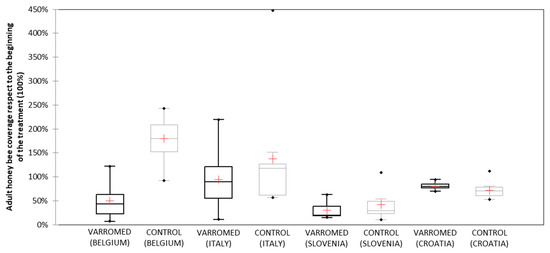
Figure 5.
Box plot of adult bee coverage in all groups recorded during the summer/autumn trial compared to the beginning of the treatment (%). The horizontal line in boxes shows the median. The box shows the first and third quartile. Whiskers extend to 1.5 × interquartile range (IQR). Diamonds mark the outliers outside the 1.5 × IQR. Additionally, the pluses show mean values.
Mean brood area compared to the control group decreased after VarroMed treatment in Italy and Slovenia (−71.1% and −3.0%, respectively) and increased in Croatia (+24.7%), but all variations were not statistically significant (Table 4; Figure 6). Brood area was not recorded in Belgium, as bees started clustering and weather conditions were prohibitive to check brood coverage properly.

Table 4.
Variation of brood area in all groups recorded during the summer/autumn trial compared to the beginning of the treatment (%).
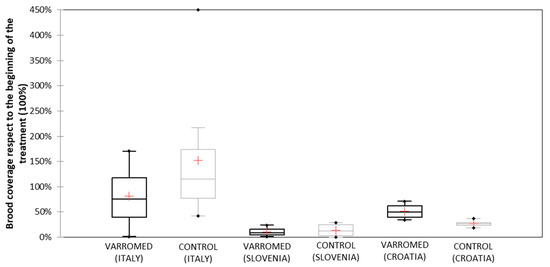
Figure 6.
Box plot of brood area in all groups recorded during the summer/autumn trial compared to the beginning of the treatment (%). The horizontal line in boxes shows the median. The box shows the first and third quartile. Whiskers extend to 1.5 × interquartile range (IQR). Diamonds mark the outliers outside the 1.5 × IQR. Additionally, the pluses show mean values.
3.2. Winter Trial
In colonies where VarroMed was applied during wintertime, in the absence of brood, the recorded acaracide efficacy ranges from 71.8% to 95.6% (Table 5; Figure 7). Efficacies in all treated groups differed when compared to control groups (Kruskal–Wallis test: H(7) = 62.07, p < 0.0001; Dunn’s tests: p < 0.05).

Table 5.
Acaricide efficacy recorded during the summer/autumn trial in the apiaries and relative mite fall during the same period in the control group (%).
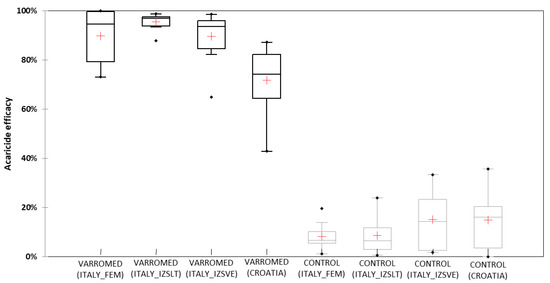
Figure 7.
Box plot of acaricide efficacies recorded during the winter trial and relative mite fall during the same period in the control group (%). The horizontal line in boxes shows the median. The box shows the first and third quartile. Whiskers extend to 1.5 × interquartile range (IQR). Additionally, the pluses show mean values.
Small variations of coverage of adult honey bees were recorded but no statistically significant differences were observed (Table 6; Figure 8). No queen mortality and no clinical signs of other economically important diseases were observed.

Table 6.
Variation of adult honey bee coverage in all groups recorded during the winter trial compared to the beginning of the treatment (%).
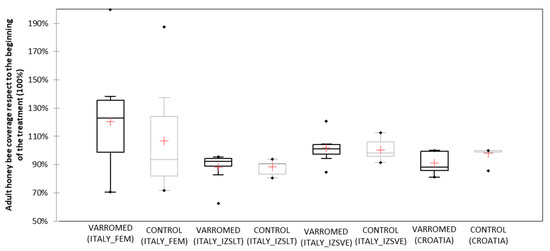
Figure 8.
Boxplot of adult honey bee coverage in all groups recorded during the winter trial and compared to the beginning of the treatment (%). The horizontal line in boxes shows the median. The box shows the first and third quartile. Whiskers extend to 1.5 × interquartile range (IQR). Additionally, the pluses show mean values.
During the summer/autumn trials, the mean environmental temperatures recorded during VarroMed treatments were as follows: 30.2 ± 2.5 °C in Croatia; 23.6 ± 1.3 °C in Italy; 15.6 ± 4.2 °C in Slovenia; 12.4 ± 2.7 °C in Belgium. During the winter trials, we recorded the following mean environmental temperatures: 7.4 ± 3.4 °C in Italy_IZSVE; 6.4 ± 3.2 °C in Italy_IZSLT; 4.2 ± 4.6 °C in Croatia and 3.3 ± 2.6 °C in Italy_FEM.
4. Discussion
Varroa mite is a major cause of overwintering honey bee (A. mellifera) colony losses across the globe [36]. In recent years, several surveys were conducted to analyze beekeepers’ treatment practices and overwintering [36,37,38,39,40]. One of the findings of the above-mentioned studies was that the worst scenario concerning the overwintering ability was a combination of weakness of honey bee populations, low food reserves and high Varroa infestation levels [37].
In our study, we administered VarroMed® in several apiaries with different climatic conditions. The average temperatures near the experimental apiaries in Croatia, Italy, Slovenia and Belgium show a versatile range (30.2–12.4 °C) only in summer/autumn treatment period in 2018. Our results show that the efficacy of VarroMed® treatment was above 70% and not highly variable, regardless of the presence of honey bee brood and environmental temperature, despite some relevant differences between minimum and maximum efficacy values in some sites, as shown in Table 2 and Table 5. High efficacies of other oxalic acid-based treatments (application by trickling or sublimation) were reported by Büchler et al. [8]. Colonies were treated in a broodless period in summer time (using brood interruption techniques, such as queen caging or brood removal) and the efficacy ranged from 48 to 89% mite removal.
The protocols of the treatments against V. destructor may require quite a long time (over 40 days) to reach a high acaricide efficacy, especially in broodright colonies with high levels of infestation [31]. The field trials were carried out in medium infested colonies and the treatment was, therefore, appropriate. In the experimental apiaries, the efficacy ranged from 71.2 to 89.3% in summer/autumn treatment. Tlak Gajger and Sušec [41] reported even higher acaricide efficacy (91.5%) in summer, after three consecutive applications of the oxalic acid based complementary feed HiveClean® (former product, comparable with VarroMed®). In winter treatments reported in this paper, the overall acaricide efficacies ranged from 71.8 to 95.6%. According to the report of the European Medicines Agency [42], the efficacy of winter treatment with VarroMed® was 88%. The level of efficacy of VarroMed® treatment in summer/autumn and winter was found sufficient, which can be supported by the average number of mite fall after queen caging and follow-up treatment.
Another critical aspect to the use of mixture of organic acids (oxalic and formic acid) and additional substances against Varroa mites that should be considered is a possible toxicity to honey bees and colonies. The use of oxalic acid by trickling, evaporation and spraying, honey bee tolerability and efficacy has been reviewed by Rademacher and Hartz [12]. In general, the application of oxalic acid in a formulation with sugar syrup increases the efficacy against Varroa mites. However, there are some negative effects of oxalic acid on queen health [43,44] and on worker bees’ digestive system [45].
Formic acid operates through the inhibition of mitochondrial energetic metabolism of Varroa mites binding the cytochrome C oxidase enzyme [46], as well as through a significant neuroexcitation process [47]. It also affects honey bee colony, as it reduces the longevity of worker bees [48] and affects brood survival [49]. There is a report on an increased number of dead bees in front of the hive, queen rejection and decrease of honey yield during treatment [50].
Considering the above-mentioned toxicity aspects, we evaluated the effects on the strength of the colonies after VarroMed® treatments. We found that the reduction in number of honey bees and brood in treated hives was very low or insignificant in all countries and in all application’s seasons except in Belgium, where fewer honey bees were observed in treated colonies and some of them even died. This finding could be explained by the lack of an ideal combination of temperature (below 15 °C), treatment (several applications) and colony condition (decreasing colony population) at the time of field trial.
It is important to highlight that our data showed that there is no need to treat in absence of brood (e.g., applying the queen caging), as a high acaricide efficacy was observed in both cases (with or without brood). The treatments were repeated several times and the duration of the treatment covered the period longer than worker developmental stage from egg to emerging. However, we want to underline the repeated applications of the product, which demand extended efforts of the beekeeper in terms of time and costs and result in higher toxicity to adult honey bees, especially in the case of environmental temperatures lower than 15 °C (mean autumn temperatures in Belgium were 12.4 ± 2.7 °C).
Finally, it is noteworthy that the producer of VarroMed® leaves the decision to apply an extra-treatment or not to the beekeepers, based on the Varroa infestation levels obtained after the previous treatment [51]. This approach to the treatment against Varroa mites based on an integrated pest management (IPM) includes the implementation of good beekeeping practices [52] and beekeeper education to achieve sustainable and successful beekeeping.
Author Contributions
Conceptualization, all authors; methodology, all authors; investigation, all authors; writing—original draft preparation, J.R.-G., M.I.S.Š., M.P. and I.T.G.; writing—review and editing, all authors; visualization, M.P.; funding acquisition, all authors. All authors have read and agreed to the published version of the manuscript.
Funding
The authors acknowledge the financial support from the Slovenian Research Agency (research core funding No. P4-0133. This work was partly supported by the Project BPractices (ERA-NET SusAn), co-financed by the European Union’s Horizon 2020 research and Innovation Program.
Institutional Review Board Statement
Not applicable.
Informed Consent Statement
Not applicable.
Data Availability Statement
The data presented in this study are available on request from the corresponding author.
Acknowledgments
We thank COLOSS (Honey bee research association) for support in the meetings and successful collaboration of partners.
Conflicts of Interest
The authors declare no conflict of interest. The funders had no role in the design of the study; in the collection, analyses or interpretation of data; in the writing of the manuscript, or in the decision to publish the results.
References
- Anderson, D.L.; Trueman, J.W.H. Varroa jacobsoni (Acari: Varroidae) is more than one species. Exp. Appl. Acarol. 2000, 24, 165–189. [Google Scholar] [CrossRef]
- Noël, A.; Le Conte, Y.; Mondet, F. Varroa destructor: How does it harm Apis mellifera honey bees and what can be done about it? Emerg. Top. Life Sci. 2020, 4, 45–57. [Google Scholar] [CrossRef] [PubMed]
- Mutinelli, F. Veterinary medicinal products to control Varroa destructor in honey bee colonies (Apis mellifera) and related EU legislation—An update. J. Apicult. Res. 2016, 55, 78–88. [Google Scholar] [CrossRef]
- Gregorc, A.; Alburaki, M.; Sampson, B.; Knight, P.R.; Adamczyk, J. Toxicity of selected acaricides to honey bees (Apis mellifera) and varroa (Varroa destructor (Anderson and Trueman) and their use in controlling Varroa within honey bee colonies. Insects 2018, 9, 55. [Google Scholar] [CrossRef] [PubMed] [Green Version]
- Bogdanov, S. Contaminants of bee products. Apidologie 2000, 37, 1–18. [Google Scholar] [CrossRef] [Green Version]
- European Commission (EC). Commission Regulation (EU) No 37/2010 of 22 December 2009 on Pharmacologically Active Substances and Their Classification Regarding Maximum Residue Limits in Foodstuffs of Animal Origin. Off. J. Eur. Union 2010, 15, 1–72. Available online: https://eur-lex.europa.eu/legal-content/EN/TXT/?uri=CELEX%3A32010R0037 (accessed on 19 June 2021).
- Rosenkranz, P.; Aumeier, P.; Ziegelmann, B. Biology and control of Varroa destructor. J. Invert. Pathol. 2010, 103, S96–S119. [Google Scholar] [CrossRef]
- Büchler, R.; Uzunov, A.; Kovačić, M.; Prešern, J.; Pietropaoli, M.; Hatjina, F.; Pavlov, B.; Charistos, L.; Formato, G.; Galarza, E.; et al. Summer brood interruption as integrated management strategy for effective Varroa control in Europe. J. Apicult. Res. 2020, 59, 764–773. [Google Scholar] [CrossRef]
- Radetzki, T.; Reiter, M.; Negelein, B.; Fischermuhle, H. Oxalsaure zur Varroabekampfung [Oxalic acid for Varroa control]. Schweiz. Bienen-Ztg. 1994, 117, 263–267. [Google Scholar]
- Imdorf, A.; Charriere, J.-E.; Bachofen, B. Wann ist die Oxalsaure als Varroazid geeignet [When is oxalic acid suitable as varroacide?]. Schweiz. Bienen-Ztg. 1995, 7, 389–391. [Google Scholar]
- Mutinelli, F.; Baggio, A.; Capolongo, F.; Piro, R.; Prandin, L.; Biasion, L. A scientific note on oxalic acid by topical application for the control of varroosis. Apidologie 1997, 28, 461–462. [Google Scholar] [CrossRef]
- Nanetti, A. Oxalic acid for mite control—Results and review. In Coordination in Europe of Research on Integrated Varroa Mites in Honey Bee Colonies; Commission of the European Communities: Gent, Belgium, 1999; pp. 9–15. Available online: http://varroa.fr/wp-content/uploads/2017/08/Fries-I.-et-al-1999.-Coordination-in-europe-of-integrated-control-of-varroa-mites-in-honey-bees-colonies.pdf (accessed on 19 June 2021).
- Rademacher, E.; Harz, M. Oxalic acid for the control of varroosis in honey bee colonies—A review. Apidologie 2006, 37, 98–120. [Google Scholar] [CrossRef] [Green Version]
- Imdorf, A.; Gerig, L. Lutte intégrée contre varroa: Acide formique. J. Suisse Apicult. 1988, 85, 311–320. [Google Scholar]
- Bolli, H.K.; Bogdanov, S.; Imdorf, A.; Fluri, P. Zur Wirkungsweise von Ameisensäure bei Varroa jacobsoni Oud und der Honigbiene (Apis mellifera L). [Title in English: Action of formic acid on Varroa jacobsoni Oud and the honeybee (Apis mellifera L). Apidologie 1993, 24, 51–57. [Google Scholar] [CrossRef] [Green Version]
- Pietropaoli, M.; Formato, G. Liquid formic acid 60% to control varroa mites (Varroa destructor) in honey bee colonies (Apis mellifera): Protocol evaluation. J. Apicult. Res. 2018, 57, 300–307. [Google Scholar] [CrossRef] [Green Version]
- Girisgin, A.O.; Aydin, L. Efficacies of formic, oxalic and lactic acids against Varroa destructor in naturally infested honeybee (Apis mellifera L.) colonies in Tureky. KAFKAS Univ. Vet. Fak. Derg. 2010, 16, 941–945. [Google Scholar]
- Rademacher, E.; Harz, M.; Schneider, S. The development of HopGuard® as a winter treatment against Varroa destructor in colonies of Apis mellifera. Apidologie 2015, 46, 748–759. [Google Scholar] [CrossRef]
- Imdorf, A.; Kilchenmann, V.; Maquelin, C.; Bogdanov, S. Optimierung der Anwendung von ’Apilife VAR’ zur Bekämpfung von Varroa jacobsoni Oud. in Bienenvölkern. Apidologie 1994, 25, 49–60. [Google Scholar] [CrossRef] [Green Version]
- Imdorf, A.; Bogdanov, S.; Ibáñez Ochoa, R.; Calderone, N.W. Use of essential oils for the control of Varroa jacobsoni Oud. in honey bee colonies. Apidologie 1999, 30, 209–228. [Google Scholar] [CrossRef] [Green Version]
- Floris, I.; Satta, A.; Cabras, P.; Garau, V.L.; Angioni, A. Comparison between two thymol formulations in the control of Varroa destructor: Effectiveness, persistence, and residues. J. Econ. Entomol. 2004, 97, 187–191. [Google Scholar] [CrossRef]
- Marinelli, E.; De Santis, L.; De Pace, F.M.; Dell’Aira, E.; Saccares, S.; Nisi, S.; Formato, G. Impiego del timolo e dell’acido formico per il controllo della varroatosi nel Lazio [Use of thymol and formic acid to control varroatosis in Latium region]. Apitalia 2007, 1, 1–4. [Google Scholar]
- Damiani, N.; Gende, L.B.; Bailac, P.; Marcangeli, J.A.; Eguaras, M.J. Acaricidal and insecticidal activity of essential oils on Varroa destructor (Acari: Varroidae) and Apis mellifera (Hymenoptera: Apidae). Parasitol. Res. 2009, 106, 145–152. [Google Scholar] [CrossRef] [PubMed]
- Ghasemi, V.; Moharramipour, S.; Tahmasbi, G. Biological activity of some plant essential oils against Varroa destructor (Acari: Varroidae), an ectoparasitic mite of Apis mellifera (Hymenoptera: Apidae). Exp. App. Acarol. 2011, 55, 147–154. [Google Scholar] [CrossRef]
- Sabahi, Q.; Morfin, N.; Emsen, B.; Gashout, H.A.; Kelly, P.G.; Otto, S.; Rod Merrill, A.; Guzman-Novoa, E. Evaluation of dry and wet formulations of oxalic acid, thymol, and oregano oil for Varroa mite (Acari: Varroidae) control in honey bee (Hymenoptera: Apidae) Colonies. J. Econ. Entomol. 2020, 113, 2588–2594. [Google Scholar] [CrossRef]
- Giacomelli, A.; Pietropaoli, M.; Carvelli, A.; Iacoponi, F.; Formato, G. Combination of thymol treatment (Apiguard®) and caging the queen technique to fight Varroa destructor. Apidologie 2016, 47, 606–616. [Google Scholar] [CrossRef] [Green Version]
- COLOSS. Available online: https://coloss.org/projects/varroa/ (accessed on 3 June 2021).
- EMA. European Medicines Agency, Committee for Medicinal Products for Veterinary Use. Guidelines on Veterinary Medicinal Products Controlling Varroa destructor Parasitosis in Bees. EMA/CVMP/459883/2008. 2008. Available online: https://www.ema.europa.eu/en/veterinary-medicinal-products-controlling-varroa-destructor-parasitosis-bees (accessed on 19 June 2021).
- Delaplane, K.S.; van der Steen, J.; Guzman-Novoa, E. Standard methods for estimating strength parameters of Apis mellifera colonies. J. Apicult. Res. 2013, 52, 1–12. [Google Scholar] [CrossRef]
- Pietropaoli, M.; Giacomelli, A.; Macrì, S.; Volterrani, A.; Pizzariello, M.; Formato, G. Considerazioni sui risultati nel Centro Italia dell’impiego di acido formico in gel (MAQS™), nella lotta alla varroa, in condizioni di presenza di covata e di melario. Apimondia Italia 2012, 1/2, 20–23. [Google Scholar]
- Dietemann, V.; Nazzi, F.; Martin, S.J.; Anderson, D.L.; Locke, B.; Delaplane, K.S.; Wauquiez, Q.; Tannahill, C.; Frey, E.; Ziegelmann, B.; et al. Standard methods for varroa research. J. Apicul. Res. 2013, 52, 1–54. [Google Scholar] [CrossRef] [Green Version]
- Addinsoft SARL. XLSTAT-Software User’s Manual, version 10; Addinsoft: Paris, France, 2010. [Google Scholar]
- Mann, H.B.; Whitney, D.R. On a test of whether one of two random variables is stochastically larger than the other. Ann. Math. Stat. 1947, 18, 50–60. [Google Scholar] [CrossRef]
- Kruskal, W.H.; Wallis, W.A. Use of ranks in one-criterion variance analysis. J. Am. Stat. Assoc. 1952, 47, 583–621. [Google Scholar] [CrossRef]
- Dunn, O.J. Multiple comparisons among means. J. Am. Stat. Assoc. 1961, 56, 52–64. [Google Scholar] [CrossRef]
- Beyer, M.; Junk, J.; Eickermann, M.; Clermont, A.; Kraus, F.; Georges, C.; Reichart, A.; Hoffmann, L. Winter honey bee colony losses, Varroa destructor control strategies, and the role of weather conditions: Results from a survey among beekeepers. Res. Vet. Sci. 2018, 118, 52–60. [Google Scholar] [CrossRef]
- Guzmán-Novoa, E.; Eccles, L.; Calvete, Y.; Mcgowan, J.; Kelly, P.G.; Correa-Benítez, A. Varroa destructor is the main culprit for the death and reduced populations of overwintered honey bee (Apis mellifera) colonies in Ontario, Canada. Apidologie 2010, 41, 443–450. [Google Scholar] [CrossRef] [Green Version]
- Haber, A.I.; Steinhauer, N.A.; van Engelsdorp, D. Use of chemical and nonchemical methods for the control of Varroa destructor (Acari: Varroidae) and associated winter colony losses in U.S. beekeeping operations. J. Econ. Entomol. 2019, 112, 1509–1525. [Google Scholar] [CrossRef]
- Oberreiter, H.; Brodschneider, R. Austrian COLOSS Survey of honey bee colony winter losses 2018/19 and Analysis of Hive Management Practices. Diversity 2020, 12, 99. [Google Scholar] [CrossRef] [Green Version]
- Vercelli, M.; Croce, L.; Mancuso, T. An economic approach to assess the annual stock in beekeeping farms: The honey bee colony inventory tool. Sustainability 2020, 12, 9258. [Google Scholar] [CrossRef]
- Tlak Gajger, I.; Sušec, P. Efficacy of varroacidal food additive appliance during summer treatment of honeybee colonies (Apis mellifera). Vet. Arh. 2019, 89, 87–96. [Google Scholar] [CrossRef]
- EMA. European Medicines Agency, EPAR Summary for the Public. 2017. Available online: https://www.ema.europa.eu/ (accessed on 19 June 2021).
- Higes, M.; Meana, A.; Suárez, M.; Llorente, J. Negative long-term effects on bee colonies treated with oxalic acid against Varroa jacobsoni Oud. Apidologie 1999, 30, 289–292. [Google Scholar] [CrossRef] [Green Version]
- Martin-Hernandez, R.; Higes, M.; Perez, J.L.; Nozal, M.J.; Gomez, L.; Meana, A. Short term negative effect of oxalic acid in Apis mellifera iberiensis. Span J. Agric. Res. 2007, 5, 474–480. [Google Scholar] [CrossRef] [Green Version]
- Gregorc, A.; Škerl, M.I. Toxicological and immunohistochemical testing of honeybees after oxalic acid and rotenone treatments. Apidologie 2007, 38, 296–305. [Google Scholar] [CrossRef] [Green Version]
- Keyhani, J.; Keyhani, E. EPR study of the effect of formate on cytochrome c oxidase (1980). Biochem. Biophys. Res. Commun. 1980, 92, 327–333. [Google Scholar] [CrossRef]
- Song, C.; Scharf, M.E. Formic acid: A neurologically active, hydrolyzed metabolite of insecticidal formate esters. Pestic. Biochem. Physiol. 2008, 92, 77–82. [Google Scholar] [CrossRef]
- Underwood, R.M.; Currie, R. The effects of temperature and dose of formic acid on treatment efficacy against Varroa destructor (Acari: Varroidae), a parasite of Apis mellifera (Hymenoptera: Apidae). Exp. App. Acarol. 2003, 29, 303–313. [Google Scholar] [CrossRef] [PubMed]
- Fries, I. Treatment of sealed honey bee brood with formic acid for control of Varroa jacobsoni. Am. Bee J. 1991, 131, 313–314. [Google Scholar]
- Johnson, R.M.; Ellis, M.D.; Mullin, C.A.; Frazier, M. Pesticides and honey bee toxicity USA. Apidologie 2010, 41, 312–331. [Google Scholar] [CrossRef] [Green Version]
- Pietropaoli, M.; Tlak Gajger, I.; Costa, C.; Gerula, D.; Wilde, J.; Adjlane, N.; Aldea-Sánchez, P.; Smodiš Škerl, M.; Bubnič, J.; Formato, G. Evaluation of Two Commonly Used Field Tests to Assess Varroa destructor Infestation on Honey Bee (Apis mellifera) Colonies. Appl. Sci. 2021, 11, 4458. [Google Scholar] [CrossRef]
- Rivera-Gomis, J.; Bubnič, J.; Ribarits, A.; Moosbeckhofer, R.; Alber, O.; Kozmus, P.; Jannoni-Sebastianini, R.; Haefeker, W.; Köglberger, H.; Smodiš Škerl, M.I.; et al. Good farming practices in apiculture. Rev. Sci. Tech. 2019, 38, 879–890. [Google Scholar] [CrossRef] [PubMed]
Publisher’s Note: MDPI stays neutral with regard to jurisdictional claims in published maps and institutional affiliations. |
© 2021 by the authors. Licensee MDPI, Basel, Switzerland. This article is an open access article distributed under the terms and conditions of the Creative Commons Attribution (CC BY) license (https://creativecommons.org/licenses/by/4.0/).